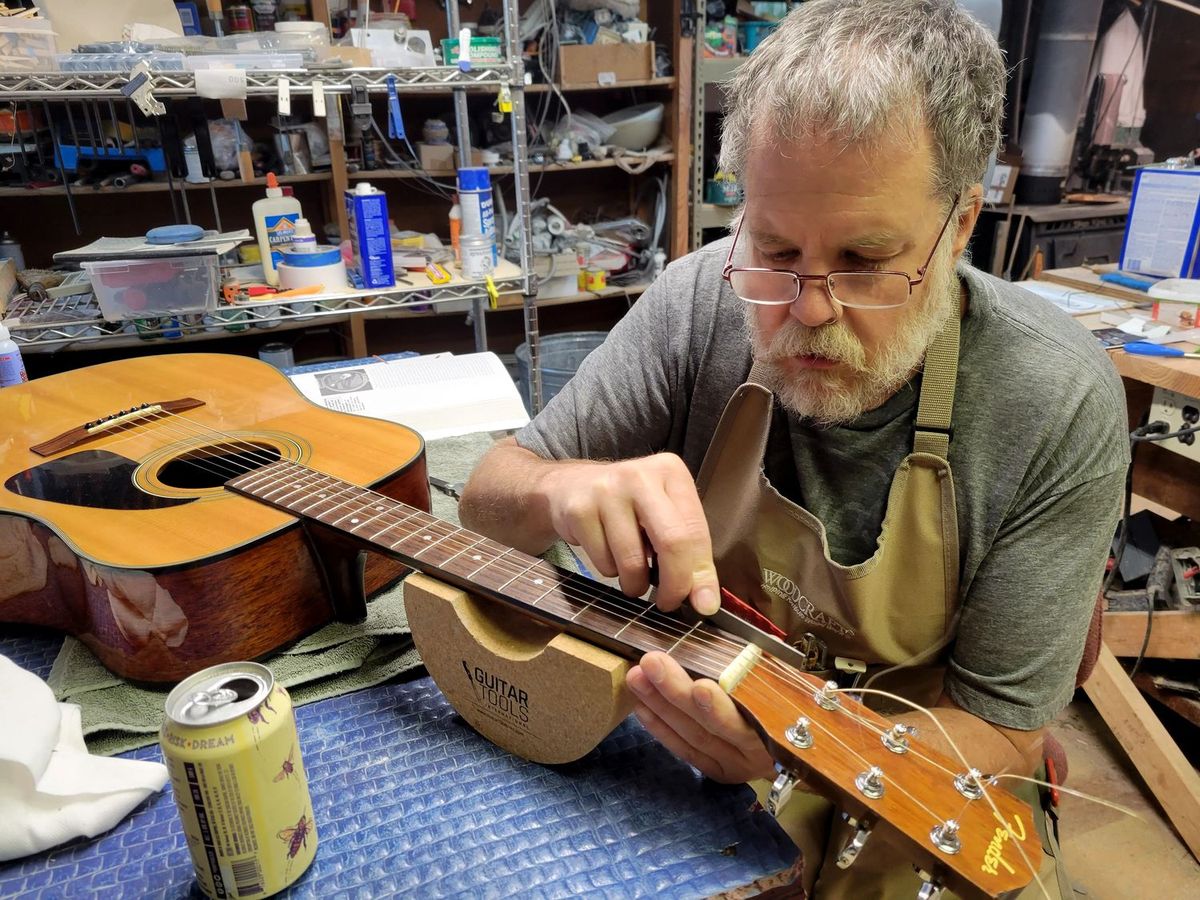Home>Instruments>Guitar>How To Become A Guitar Luthier


Guitar
How To Become A Guitar Luthier
Published: February 12, 2024
Learn how to become a skilled guitar luthier and master the craft of building and repairing guitars. Discover the essential skills and knowledge needed to excel in this specialized field.
(Many of the links in this article redirect to a specific reviewed product. Your purchase of these products through affiliate links helps to generate commission for AudioLover.com, at no extra cost. Learn more)
Table of Contents
Introduction
Introduction
Are you passionate about guitars and fascinated by the craftsmanship behind these beautiful instruments? If so, the world of guitar luthiery might be the perfect fit for you. Becoming a guitar luthier allows you to blend your love for music with the art of woodworking, creating instruments that resonate with soulful melodies and captivating rhythms.
In this comprehensive guide, we will explore the journey to becoming a skilled guitar luthier. From understanding the role and responsibilities to developing essential skills, pursuing education and training, building a portfolio, and establishing a business, we will delve into the various aspects of this rewarding career path.
Whether you dream of crafting acoustic masterpieces, electric marvels, or classical wonders, the path to becoming a guitar luthier is both challenging and immensely rewarding. So, grab your chisels, sandpaper, and a keen eye for detail as we embark on this enchanting journey into the world of guitar luthiery.
Understanding the Role of a Guitar Luthier
Before delving into the intricacies of guitar luthiery, it’s crucial to grasp the multifaceted role of a guitar luthier. Beyond the surface of crafting and repairing guitars, luthiers are entrusted with the art of shaping raw materials into harmonious instruments that resonate with musicians and enthusiasts alike.
One of the primary responsibilities of a guitar luthier is to meticulously construct, repair, and customize guitars. This involves a deep understanding of the instrument’s anatomy, including the body, neck, fretboard, bridge, and various hardware components. Luthiers must possess a keen eye for detail and an acute understanding of how each element contributes to the overall sound and playability of the instrument.
Moreover, a guitar luthier serves as a custodian of tradition and innovation. While honoring time-honored techniques and designs, luthiers also explore innovative methods and materials to push the boundaries of guitar craftsmanship. This delicate balance between tradition and innovation distinguishes exceptional luthiers from the rest, as they breathe life into each guitar they create or restore.
Furthermore, luthiers often act as consultants, guiding musicians and collectors in selecting or customizing instruments that align with their unique preferences and playing styles. This aspect of the role demands strong interpersonal skills and a deep understanding of the sonic nuances that differentiate various guitar models and tonewoods.
Ultimately, the role of a guitar luthier extends beyond technical prowess; it embodies a profound passion for music, an unwavering commitment to excellence, and a reverence for the rich heritage of guitar making. As we venture further into the realm of guitar luthiery, we’ll explore the essential skills and knowledge required to thrive in this captivating vocation.
Developing Essential Skills
Becoming a proficient guitar luthier necessitates a diverse set of skills that encompass both technical expertise and artistic sensibility. Here are the essential skills to cultivate on the path to mastering the craft of guitar luthiery:
- Woodworking Mastery: A deep understanding of woodworking techniques, including carving, shaping, and joinery, is fundamental to crafting and repairing guitars. Proficiency in using hand tools and power tools is essential for working with various tonewoods and crafting intricate guitar components.
- Understanding Guitar Anatomy: Luthiers must intimately comprehend the components of a guitar, from the bracing inside an acoustic guitar to the intricate wiring of electric guitars. This knowledge enables luthiers to diagnose issues, customize instruments, and optimize their tonal characteristics.
- Attention to Detail: Meticulous attention to detail is a hallmark of exceptional luthiery. From fret dressing to applying flawless finishes, luthiers must exhibit precision and care in every aspect of guitar construction and restoration.
- Acoustic Principles: A profound understanding of acoustic principles is essential for crafting resonant and balanced instruments. Luthiers must comprehend the impact of body shape, bracing patterns, and tonewood selection on the sonic properties of guitars.
- Problem-Solving Aptitude: Luthiers often encounter complex challenges when repairing or customizing guitars. Developing strong problem-solving skills equips luthiers to overcome hurdles and deliver innovative solutions.
- Artistic Flair: Beyond technical proficiency, luthiery demands a touch of artistry. From designing unique inlays to creating elegant bindings, infusing artistic flair into guitar making sets exceptional luthiers apart.
Aspiring luthiers can hone these skills through hands-on practice, apprenticeships with experienced luthiers, and dedicated study of guitar construction and repair techniques. By mastering these essential skills, individuals can pave the way for a fulfilling and impactful journey in the realm of guitar luthiery.
Education and Training
While a formal education is not a strict requirement for becoming a guitar luthier, pursuing specialized training can significantly accelerate skill development and provide invaluable knowledge. Several avenues exist for individuals seeking to embark on a structured educational journey in luthiery:
- Apprenticeships: Apprenticing under seasoned luthiers offers a hands-on and immersive learning experience. Through apprenticeships, aspiring luthiers gain practical insights, refine their skills, and absorb time-honored techniques passed down through generations.
- Vocational Schools and Workshops: Many vocational schools and luthiery workshops offer comprehensive courses tailored to aspiring luthiers. These programs cover woodworking fundamentals, guitar construction and repair techniques, and the nuances of tonewood selection and instrument customization.
- Online Courses and Resources: The digital landscape provides a wealth of online courses, tutorials, and resources for individuals keen on delving into luthiery. From video tutorials on guitar building to in-depth guides on guitar repair, the internet offers accessible avenues for skill enhancement.
- Specialized Programs: Some higher education institutions and specialized luthiery schools offer structured programs focusing on the art and science of guitar making. These programs often delve into advanced topics such as acoustic physics, guitar design, and the historical evolution of stringed instruments.
Furthermore, continuous self-study and a voracious appetite for learning are indispensable for honing luthiery skills. Delving into books, journals, and resources that dissect the intricacies of guitar construction, tonal dynamics, and instrument maintenance can enrich an aspiring luthier’s understanding and proficiency.
Ultimately, the path to becoming a skilled guitar luthier is illuminated by a blend of hands-on experience, structured education, and a perpetual quest for knowledge. By embracing diverse educational opportunities, individuals can sculpt their passion for luthiery into a formidable expertise that resonates through the instruments they create and restore.
Building a Portfolio
Establishing a compelling portfolio is a pivotal step for aspiring guitar luthiers, serving as a testament to their craftsmanship, creativity, and dedication to the art of instrument making. A robust portfolio not only showcases a luthier’s technical prowess but also conveys their unique artistic vision and ability to bring forth instruments that resonate with musicians on a profound level.
Here are essential strategies for crafting a captivating luthiery portfolio:
- Documenting Projects: Thoroughly document each luthiery project, capturing the various stages of guitar construction or restoration through photographs and videos. Detailing the process, from selecting tonewoods to applying finishes, provides insight into the luthier’s meticulous approach and commitment to excellence.
- Highlighting Customization: If engaging in guitar customization, emphasize the personalized elements incorporated into each instrument. Whether it’s intricate inlays, unique body shapes, or custom hardware, showcasing the bespoke features amplifies the luthier’s capacity for tailoring instruments to individual preferences.
- Recording Sound Samples: Accompanying visual documentation with audio samples allows potential clients and enthusiasts to experience the sonic character of the luthier’s creations. Demonstrating the tonal nuances and playability of the instruments adds a dynamic dimension to the portfolio.
- Client Testimonials: Incorporating testimonials from satisfied clients who have experienced the luthier’s craftsmanship firsthand adds credibility and fosters trust. Genuine feedback from musicians who have embraced the luthier’s instruments can profoundly influence prospective customers.
- Showcasing Diverse Styles: Displaying a range of instruments across different guitar styles, such as acoustic, electric, and classical, illustrates the luthier’s versatility and proficiency in catering to varied musical genres and preferences.
Moreover, leveraging digital platforms such as a professional website, social media, and online luthiery communities enables luthiers to disseminate their portfolio to a global audience. Engaging in guitar exhibitions, craft fairs, and industry events also provides opportunities to present instruments in person and forge meaningful connections within the music community.
By meticulously curating a comprehensive and visually captivating portfolio, aspiring luthiers can articulate their narrative as artisans and position themselves for recognition and success in the competitive landscape of guitar luthiery.
Establishing a Business
Transitioning from a skilled luthier to a successful business owner requires strategic planning, a deep understanding of the market, and a passion for promoting the artistry of handcrafted instruments. Here are essential steps to consider when establishing a luthiery business:
- Market Research: Conduct thorough market research to identify the demand for handcrafted guitars in your target demographic. Understanding the preferences of musicians and collectors can guide your approach to crafting instruments that resonate with potential customers.
- Business Plan: Develop a comprehensive business plan that outlines your luthiery’s mission, target market, pricing strategy, marketing initiatives, and long-term growth projections. A well-crafted business plan serves as a roadmap for navigating the competitive landscape and achieving sustainable success.
- Legal and Financial Considerations: Registering your luthiery as a legal entity, securing necessary permits and licenses, and setting up a sound financial infrastructure are critical steps in establishing a legitimate and sustainable business.
- Brand Identity: Cultivate a compelling brand identity that encapsulates the essence of your luthiery. From crafting a distinctive logo to articulating your brand’s story, forging a compelling brand identity sets the stage for building a loyal customer base.
- Online Presence: Establish a professional website showcasing your portfolio, services, and the story behind each instrument. Embrace digital marketing strategies to amplify your online visibility and engage with potential clients through social media and content marketing.
- Networking and Collaboration: Forge connections with musicians, music stores, and industry professionals to expand your reach and foster collaborative opportunities. Building a network within the music community can open doors for showcasing your instruments and garnering valuable insights.
- Customer Experience: Prioritize exceptional customer service and a personalized experience for clients seeking bespoke instruments. Nurturing meaningful relationships with customers can foster brand loyalty and generate positive word-of-mouth referrals.
Embracing the entrepreneurial journey as a luthier demands a harmonious blend of artistic passion and business acumen. By navigating the intricacies of establishing a luthiery business with diligence and creativity, aspiring luthiers can cultivate a thriving enterprise that celebrates the timeless allure of handcrafted guitars.
Conclusion
Embarking on the path to becoming a guitar luthier is a journey infused with creativity, dedication, and a profound reverence for the art of instrument making. From understanding the multifaceted role of a luthier to cultivating essential skills, pursuing education and training, building a captivating portfolio, and establishing a thriving business, the luthiery vocation beckons individuals with a passion for music and craftsmanship.
Aspiring luthiers are tasked with preserving tradition while embracing innovation, crafting instruments that resonate with soul-stirring melodies and enduring beauty. The fusion of woodworking mastery, acoustic principles, and artistic flair culminates in instruments that bear the indelible mark of their creators, embodying a symphony of skill and passion.
While the journey to mastery may present challenges, the rewards are boundless. Each guitar crafted or restored carries the luthier’s narrative, echoing their dedication to excellence and their unwavering pursuit of sonic perfection. As luthiers hone their craft, they become custodians of musical legacies, shaping the harmonious companions that accompany musicians on their artistic odysseys.
In the ever-evolving landscape of luthiery, the fusion of tradition and innovation propels the craft forward, inspiring luthiers to push the boundaries of creativity and craftsmanship. By embracing the artistry of luthiery, individuals embark on a transformative journey, sculpting their passion into instruments that resonate with the hearts and souls of musicians and aficionados worldwide.
So, to all aspiring guitar luthiers, may your chisels carve melodies, your hands shape dreams, and your instruments harmonize with the symphony of human emotion. As you tread the path of luthiery, may your journey be adorned with the timeless resonance of handcrafted guitars, each string vibrating with the essence of your artistry and devotion.











